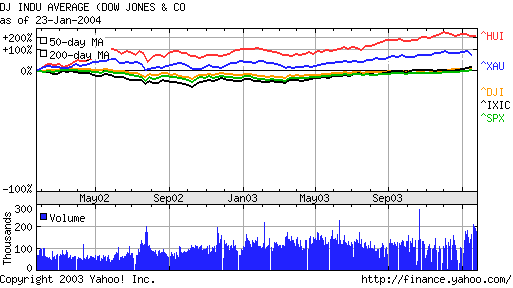By
Keith W. Rabin
 NEW
YORK (KWR) If you invested in gold during the 1990s, it was
clearly an exercise in frustration. However, the tide turned
in the early 2000’s as long depressed metals prices came
roaring back. Gold is becoming one of the new “hot” ideas
for the general investing public, though dedicated gold investors
have long been positioned to take advantage of the improved
pricing environment. Where is gold going? While there is likely
to be some continuing consolidation occurring over the near
term, we see gold continuing to rise over coming years as a
number of key factors favor an upward sloping price projection
. Although we are not so bold to predict that gold will go
over $500 an ounce over the coming year and would not be surprised
to see a continuing consolidation over the short term, it still
has room to go and constitutes a sound investment opportunity.
NEW
YORK (KWR) If you invested in gold during the 1990s, it was
clearly an exercise in frustration. However, the tide turned
in the early 2000’s as long depressed metals prices came
roaring back. Gold is becoming one of the new “hot” ideas
for the general investing public, though dedicated gold investors
have long been positioned to take advantage of the improved
pricing environment. Where is gold going? While there is likely
to be some continuing consolidation occurring over the near
term, we see gold continuing to rise over coming years as a
number of key factors favor an upward sloping price projection
. Although we are not so bold to predict that gold will go
over $500 an ounce over the coming year and would not be surprised
to see a continuing consolidation over the short term, it still
has room to go and constitutes a sound investment opportunity.
Depending upon ones investment orientation, the performance of precious metals
over the past few years has either been surprising or the natural byproduct of
the excessive worldwide fiscal and monetary stimulation caused by U.S. Federal
Reserve Board policy. Furthermore, a higher degree of political risk, directly
linked to the new cold war of the 21st century – terrorism, societal upheaval
related to the globalization of markets -- and resistance to that process – as
well as a falling out of the former major Cold War allies over the Iraq war have
contributed to the greater degree of market uncertainty that favors precious
metals. To this we add the decline of the dollar and extremely low interest rates,
all of which enhance the value of gold as a storehouse of value. As a result,
both the unhedged Gold Bugs (^HUI) and hedged Gold/Silver Index (^XAU) have substantially
outperformed the Dow Jones, Nasdaq and S&P Index over the past two years.

As readers of numerous analytical reports we are actively aware of the current
debate as to whether gold remains in a “multi-year secular bullish trend” or
whether the current consolidation seen since gold hit multi-year highs late
last year will now enter into a full-blown correction. The answer is over the
short term no one really knows for sure, but we think the question itself misses
the point.
In addition to all the fundamental reasons often used to create a bullish case
for gold, we believe one of the key reasons that gold-related shares will continue
their upward projection is that overall equity supply trends will lead to a
further appreciation over time. Yes, recent reports indicate that the Toronto
Stock Exchange and Venture Exchange was home to nearly 1,600 mining equity
financings worth $4.18 billion in 2003, with a worldwide deal flow of almost
$10 billion. However, with all the talk seen in recent months from investors
and the financial media, the entire capitalization of the entire gold and silver
market as of late November, according to Mineweb,
totaled only $120 billion.

To provide a simple comparison, General Electric and Microsoft have market
capitalizations exceeding $300 billion, and Walmart and Intel both exceed $200
billion. Coca Cola registers about $120 billion, roughly the same size as the
entire market for all gold and silver companies.
Coca Cola is admittedly a large company with over 56,000 employees. However,
as present trends continue and investors around the world increasingly turn
to hard assets as a safe haven and store of value, it is hard to see how demand
for precious metals and related equities will not continue.
It may be true that gold and precious metal shares are overbought at the present
time, (a situation not helped by the central bank of Germany’s recent
decision to sell their gold reserves) and that the sector is gaining a lot
more attention within the financial media. In addition a lot of the present
volatility might be attributed to aggressive hedge funds seeking to gain quick
profits by bidding up or down prices. Despite all of this, however, most retail
investors have minimal gold exposure and have not yet begun to focus on metals
at the present time. Even if one looks at the major copper and nickel companies,
such as Phelps Dodge and Inco, which have also appreciated strongly over the
past year, the actual investment is relatively small. While both of these firms
have developed loyal followings, together they are not as large as Newmont
Mining, the largest gold mining company. Newmont has a market cap slightly
over $17 billion as opposed to Phelps Dodge ($6.8 billion) and Inco ($7.1).
To provide a point of comparison, Eastman Kodak has a market cap of $8.6 billion.
Most metals-oriented conferences and events – while attracting more attention
in years past – still do not attract anywhere near the interest of more
mainstream investments. At one presentation held last week highlighting a Canadian
gold exploration company here in New York for retail and small institutional
investors, there were little more than a dozen people in attendance. From the
questions it was clear most could not even distinguish between exploration
and mining companies. That seems hardly the sign of a market top, when all
people with a possible interest are invested. Even precious metals-oriented
mutual funds are relatively small. Cursory research reveals none of these funds
have net assets exceeding $1 billion. The bottom line is that the small investor – who
helps create a bubble of rising prices and expectations – has yet to
be fully engaged.
Many analysts reject the supply argument noted above on the grounds that ultimately
equities are valued based on earnings and gold and precious metals companies
have not delivered in that regard. There is certainly some truth to this line
of thinking, however, we would argue given the nature of the mining process,
all increases in the price of the underlying metal above extraction and administrative
costs will fall to the bottom line. As a result, a sustained increase in metals
prices will likely lead to dramatic upside surprises in the profitability of
mining companies. It is also important to note that many mining companies – in
gold and otherwise – have considerably reduced their inventories. There
is a less supply than in the past, while demand is on the rise for gold as
well as copper, nickel, zinc and many other commodities.
Furthermore, given the sparse investment into new mining properties that has
taken place over the past two decades, we could begin to see an upturn in the
M&A environment within the sector as major producers seek to acquire properties
that can help to boost their reserves.
On the other hand, higher prices for gold has also led to an increasing number
of secondary financings. After a $1 billion financing last November, Newmont
Mining, the world's largest gold producer, filed with regulators last week
to raise up to $200 million for a possible acquisition and to sell up to another
$1 billion in debt and stock. While we still believe the aggregate amount is
still small compared to the demand that will arise over the next few years,
many analysts point to the dilutions and added supply that will result
as evidence that the move in precious metals has past.
This may indeed be true over the short term, and there may indeed be better
entry opportunities in the near future – however, the basic fundamentals,
which include, but are not limited to, a declining dollar, highly simulative
central banking policy in the U.S. and many other economies, stronger long-term
growth in China, India and other developing countries, as well as the relatively
low level of investment and equity supply following an almost two decade bear
market in the commodity sector -- all point to continuing appreciation over
time. While we do not necessarily see gold going over $500 in the near term,
and would not be surprised to see a continuation of the current consolidation, it
has room to run and the potential to surprise on the upside, especially if – and
ultimately when -- greater uncertainty begins to creeps back again into equity
markets.
(read
Part II of this Special Report: Commodities and Gold)



